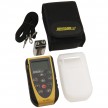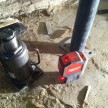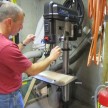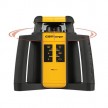Milwaukee Laser Distance Meter Kit 2280-20
Milwaukee Laser Distance Meter Kit model number 2280-20 Review
By Jeff Kirk, Journeman Carpetner
My latest review is of the Milwaukee Laser Distance Meter Kit model number 2280-20. Upon opening it i was very impres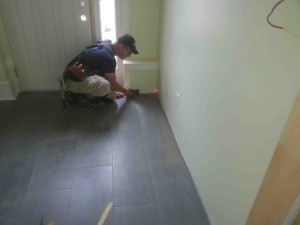 sed at how compact it is at 1″ thick, 2 ” wide and 4 1/2″ long, The outside of it is composed of the standard red Milwaukee plastic and has rubber on it to protect against bumps and drops. there;s virtually no weight to it to notice at all compared to a 100′ tape used for measuring sq footage.
sed at how compact it is at 1″ thick, 2 ” wide and 4 1/2″ long, The outside of it is composed of the standard red Milwaukee plastic and has rubber on it to protect against bumps and drops. there;s virtually no weight to it to notice at all compared to a 100′ tape used for measuring sq footage.
Whats Included:
The laser comes with 2 AAA batteries which is a bonus so you wont have to buy batteries separately. Also included is a Ballistic nylon holder which has a Velcro strap on it so you can hang it off your belt. the case is perfectly fitted to the laser so it wont slip around in it our fall out.
On the bottom of the tool is a metal clip that folds down, when folded out to 90 degrees to the tool it can be hooked on to outside corners to take a measurement more accurately than trying to align the bottom of it with the corner. To take an inside measurement its just a matter of butting the tool into the corner and shooting the laser towards the opposite surface.
Capabilities and Features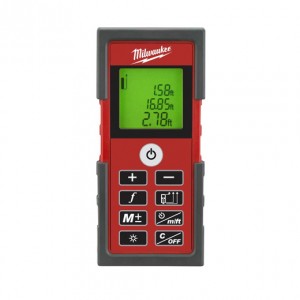
A very impressive feature on this tool is that the laser and the range detector are in the exact same instrument which means taking measurements is a one person task, there’s no need for a second person to hold a detector on the other end.
The specs on the laser’s maximum distance is 197 feet accurate to within .005″. They have made the tool to be more than simply a range finder, it has settings for calculating both square feet and cubic feet along for both square areas and triangular spaces, Perfect for doing estimates for siding, paint or flooring.
One key feature to note on the laser is for taking inside measurements and outside measurements the setting on the laser for where the measurement is taken from on the tool can be changed into 3 modes.
1. It allows measurement from the nose of the laser which is good for rough measures.
2. It will measure to the bottom of the laser, which I primarily was using for getting distances between to walls by simply butting the laser to one wall and shooting at the adjacent wall.
3. The 3rd setting allows 1″ extra which requires extending the little metal clip straight out of the bottom.
One really cool feature I really liked was the memory setting. Typically I would carry both a standard tape measure and either a notepad or a block of wood to write down my measurements. The Milwaukee 2280 laser takes multiple measurements, and stores them for you. You can store for up to 10 measurements which is perfect for installing baseboard.
The ability to do store multiple measurements allowed me to make my entire cut list, allowing me to make multiple cuts at the miter saw.
Another feature is the “green colored” back light which can be turned on and off when using the laser in dark spaces.
Jobsite Testing and Accuracy:
Over the period of a week and a half I tested the laser we used it in 3 different situations; deck Building, interior trim and overall range.
Initially upon opening the laser I tested its accuracy against two standard carpenters tape measures, both for inside and outside measurements.The Laser was reading within 1/32 ” of what the tape measures were reading, the reason for testing it against 2 tapes was simply to get a better idea of accuracy as tape measure readings can vary based on the amount of play in the hook.
Framing Application:
In the Framing and deck building tests I used the laser to fit a laminated post into an existing wall pocket and also to pick up a new point load.
The laser eliminated having to bend the tape when measuring between the top and bottom plate, I simply sat the laser on the bottom plate and shot a beam up to the top plate. The range finder also came very useful for squash block lengths that were installed between the first floor’s sheathing and the basement bearing wall.
Deck Building:
During the deck building it was used for getting joist lengths on a 16′ wide deck.. The ability to simply shoot a beam allowed me to take measurements without a 2nd pair of hands on the other end to hold my tape, that alone frees up a guy to work on something else. Not only was it used for joist lengths i used it for getting lengths of 2×4’s between the 4×4 hand rail posts.
Interior Trim:
For interior trim it was extremely accurate for both baseboard and crown molding measurements. The metal plate came in handy for taking long point/ short point measurements plus I was able to take measurements solo for long lengths of crown molding. the laser allowed me to get more accurate measurements than with my tape measure when measuring into a corner.
Overall Range:
To test the overall range of the laser Ichecked it outdoors both at night and in the middle of the day in bright sunlight. The only weak point of the laser showed in the range test was in bright natural light. The lasers range diminished by half in the sun light. The longest reading I was able to get was 85 ‘, the natural light seems to break up the beam or inhibit the range finders ability to pick up the beam at longer distances.
Testing the laser outdoors at night however gave me great results. The longest measurement was able to take was 167′ the next furthest surface was beyond the lasers 197’ range.
Best suited for
- Finish carpenters who need precise measurements for accurate cuts
- Estimators for drywall, paint, flooring, siding, for figuring out square footage
- Interior wall and ceiling system installers
- Architects
Overall Impression:
The Milwaukee Laser Distance Meter Kit 2280-20 has extremely accurate readings, multiple modes for calculating area. and long range capabilities in such a small package definitely make it a worthwhile instrument to add to the tool box. Canadian pricing puts it at $209.99
About the Author:
Jeff Kirk is a Journeyman carpenter for TopSailProjects.com in Halifax, Canada and tool reviewer for AConcordCarpenter.com



